Focus On Quality Audio Creative Instead Of Length Of Ad – Here’s Why
Advertisers are often curious about the merits of the length of various audio creative – 30-second ads versus 60-second ads; 30-second ads versus 15-second ads.
Westwood One has tested hundreds of audio ads with firms like ABX, VERITONIC, MARU/Matchbox, and Nielsen, all leaders in creative testing. The truth is there aren’t significant differences between creative scores when comparing length of the spot. Yes, longer ads perform better, but there isn’t a massive difference in scores.
While commercial length might not be a major effectiveness driver, there are ways to optimize ads. Here are three best practices for how to maximize the impact of audio creative:
1. The fewer messages, the better the advertising recall
Creative testing giant Millward Brown reports the more messages an ad attempts to communicate, the lower the likelihood of a single message being communicated. Their data shows that the first message in an ad with four messages has only 43% of the recall of an ad with one message.
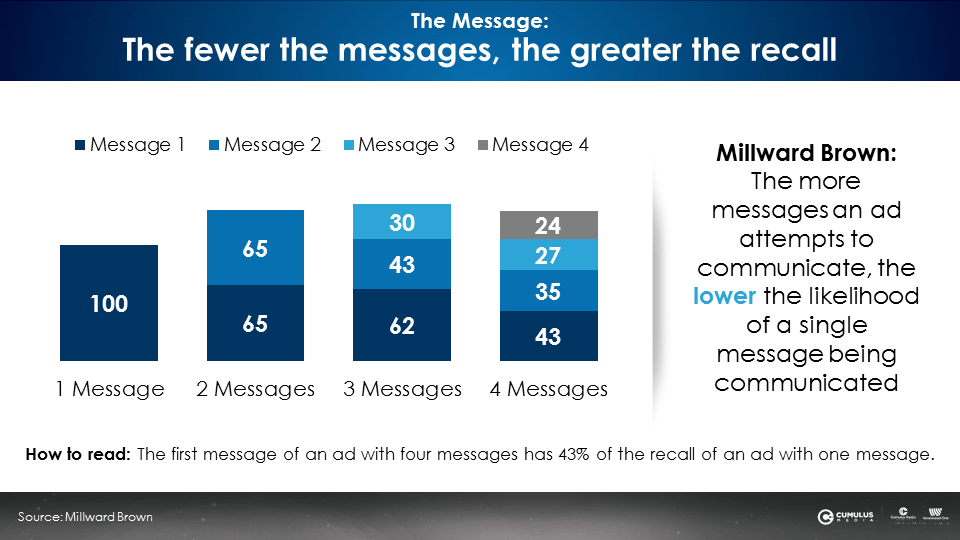
How many messages is your creative trying to communicate? The more messages crammed into the ad, the less likely consumers can recall the messages. A 15-second ad with one simple message will generate better recall than a 30-second ad with three or four messages.
Chris Smith, writer and Brand Creative Group Head at The Richards Group, advises his clients, “Be single-minded: Say one thing.” He explains, “A lot of advertisers think that because radio affords you sixty or thirty seconds, they have the time to say everything there is to say about their brand. It’s why so many commercials end up sounding like laundry lists. The truth is, if you want to talk about everything, then you really have nothing to talk about.
In advertising, you need to have one thing to say. AM/FM radio’s sixty seconds of ad time just gives you the chance to say it in an entertaining and memorable way.”
He cites a Snickers ad to illustrate the point: “They have one idea – you’re not at your best when you’re hungry. They spend most of the ad being entertaining, holding the attention of the audience, and serving the one central idea.”
2. Prioritize brand building over sales activation
Les Binet, Head of Effectiveness at adam&eveDDB, and Peter Field, Marketing Consultant, studied the IPA Databank, the world’s largest database of marketing case studies for their book The Long and Short of It: Balancing Short and Long-Term Marketing Strategies.
Based in London, the Institute of Practitioners in Advertising (the IPA), maintains the IPA Databank of over 1,200 case studies submitted to the IPA’s Effectiveness Awards Competition. Covering a broad spectrum of marketing categories and budgets, they “represent the most rigorous proofs of the effectiveness of marketing communications in the world.”
Binet and Field, “the godfathers of marketing effectiveness,” explain that the goal of sales activation “is to focus on people who are likely to buy in the very near future. That means exploiting existing brand equity to generate sales right now.”
Sales activation campaigns are the “carbs of advertising,” producing a sugar rush of short-term sales and then a crash. Sales activation features rational copy and tight targeting. In their book Media in Focus: Marketing Effectiveness in the Digital Era, Binet and Field report that “activation effects are relatively easy to measure, because they tend to be big, immediate and direct. In the short term (six months or less) they tend to produce the biggest sales responses.”
Binet and Field show how sales activation campaigns (the grey line below) generate sales uplift through a series of short-term sales spikes that quickly collapse.
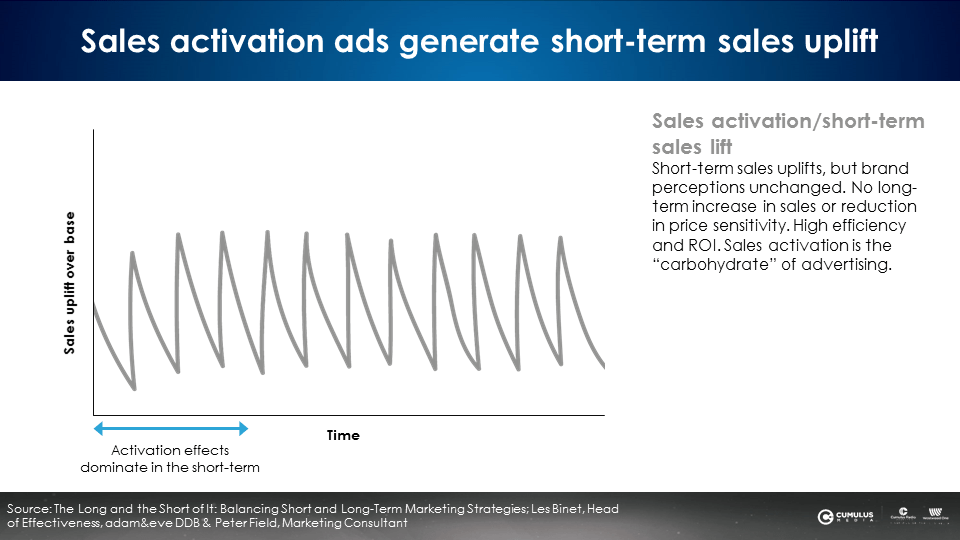
Brand building campaigns: the “protein of advertising.” Of the two types of campaigns, brand building is harder to achieve, requires greater investment, and is more important. According to Binet and Field, “Brand building means creating mental structures (associations, memories, beliefs, etc.) that will pre-dispose potential customers to choose one brand over another. This is a long-term job involving conditioning consumers…so it takes time; talking to people long before they come to buy.”
Brand building requires mass reach media like television and AM/FM radio. That’s because the goal is to target everyone in the category, even if they are not in the market right now. While short-term sales uplifts are smaller, brand building sales effects (the blue line below) grow and grow over time, becoming the main driver of long-term growth and profit.
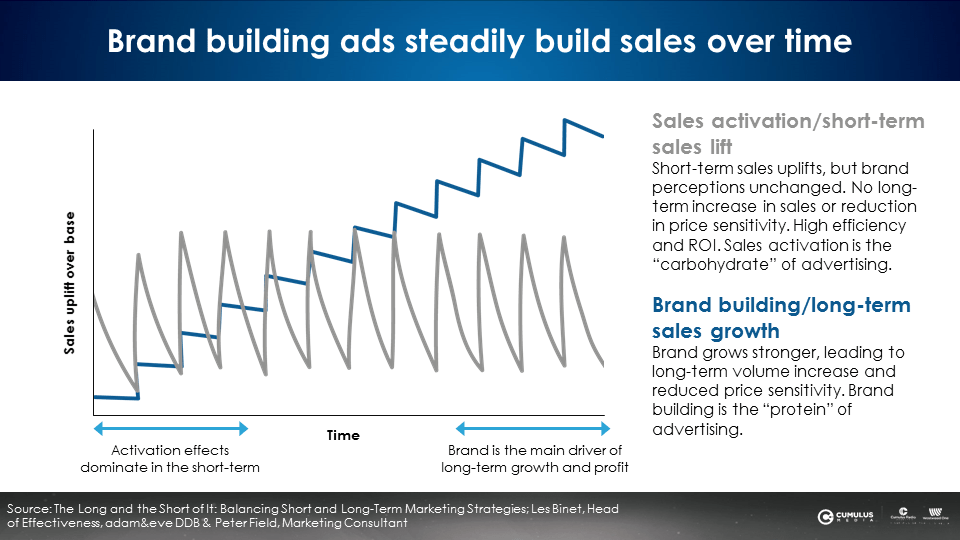
The massive number of marketing effectiveness studies analyzed by Binet and Field reveal that the sales effects of brand building “decay away more slowly…in the long run, brand effects are the main driver of growth.” Binet and Field find that the ideal mix of marketing investments should be 60% brand building and 40% sales activation.
3. Focus creative on emotional messaging versus rational
Building top of mind recall and brand awareness is all about reach. Ensuring that a brand is liked and understood is the job of brand advertising. Do you build a brand with facts and logical assertions or with emotion-based storytelling?
The Binet and Field analysis found that emotional campaigns build brands more strongly regardless of the measure: awareness, commitment, trust, differentiation, fame, or image. Emotional campaigns are far more powerful at building brands. They create emotional bonds and associations.
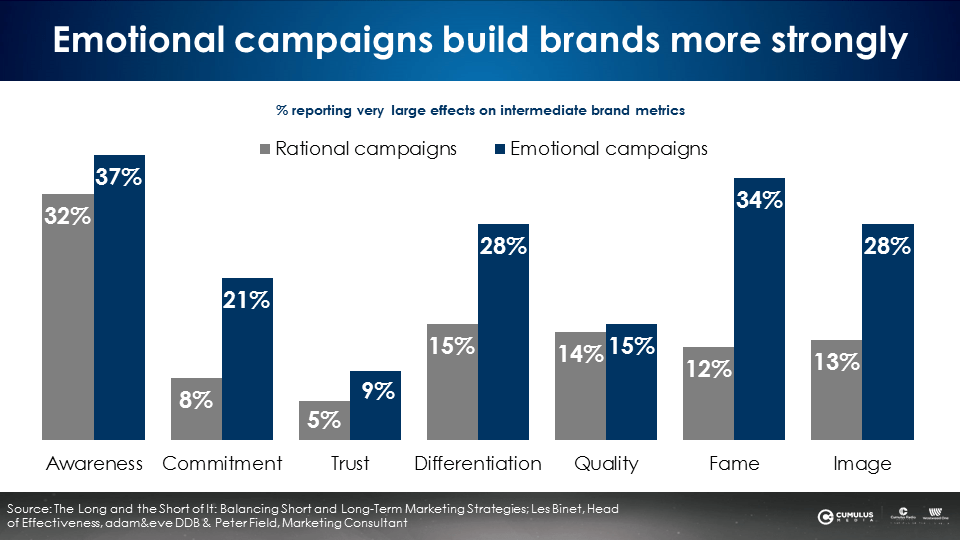
What about concrete business outcomes like sales, profit, and share? Binet and Field found emotional-based advertising generates far stronger business results for these outcomes as well.
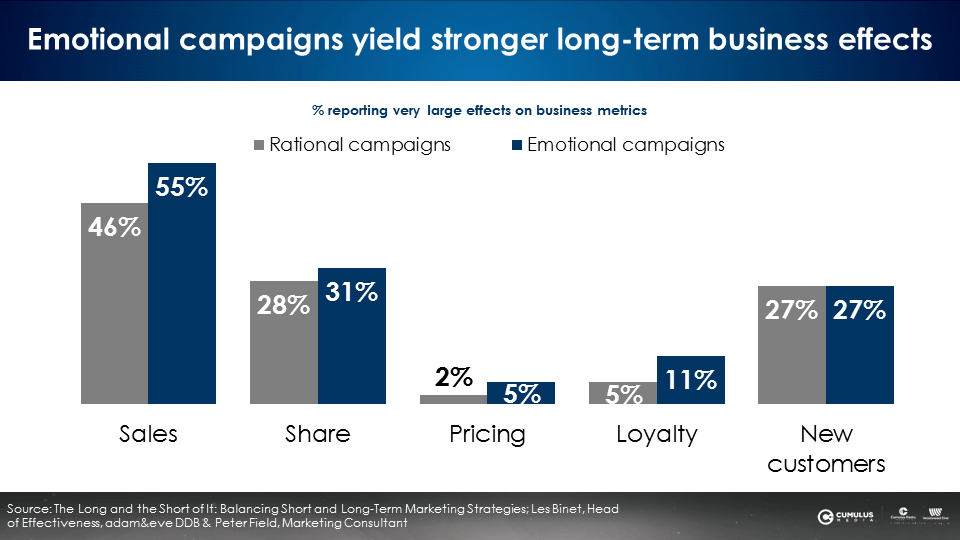
Emotional campaigns drive higher long-term sales, share, pricing power, and loyalty. Over time, Binet and Field found that emotional campaigns are far more profitable: “Emotional campaigns’ effects last longer than rational ones and so build more strongly over time: this is especially true of profitability, because of the multiplier effects of emotional campaigns, on both volume and pricing.”
Don’t get caught up on spot length. In the grand scheme of audio creative, the length of an ad is a minor factor in effectiveness. Instead, focus on the number of messages included, your mix of brand building and sales activation, and utilizing emotional copy over rational messaging to influence the effectiveness of creative.
Best practices for optimizing audio ads:
- The fewer messages, the better the advertising recall
- Prioritize brand building over sales activation
- Focus creative on emotional messaging versus rational
Pierre Bouvard is Chief Insights Officer at CUMULUS MEDIA | Westwood One.
Contact the Insights team at CorpMarketing@westwoodone.com.